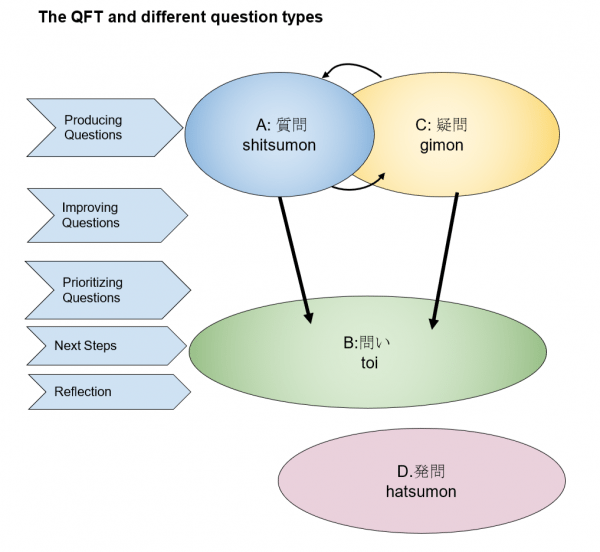I’ve been pondering the word “question” for the last couple months. How do you translate “Question Formulation Technique” into Japanese – a language with four words for “question?”
by Tomoko Ouchi
Not all questions are the same
I was born, raised and educated in Japan, and as The Right Question Institute’s international program specialist, I helped prepare and translate material for seminars RQI conducted in Tokyo, Kyoto and Hiroshima last March.
As I did this work I began to feel distinctly alarmed about one small but fundamental translation issue. A very important word in the Question Formulation Technique has no straightforward counterpart in Japanese. That word is “question.” In Japanese it doesn’t have a perfect fit.
Translation is not easy, and it cannot always be perfect. Ultimately, while RQI Co-Director Dan Rothstein and I were in Japan, we used the word from the translated version of Make Just One Change: Teach Students to Ask Their Own Questions, which had become a best-selling education title in my home country.
However, in the back of my mind this translation conflict has never gone away. How do you articulate the different kinds of questions the QFT generates in the nuances of another language? How might inaccurate translation undermine the power and sophistication of this process? What type of questions and answers are we really talking about at the beginning, middle, and end of the QFT process, and are they all the same kind?
Japanese words for question
In Japanese, there are four words that mean “question.” They have different implied meanings, and the way each is used is different.
Here are the definitions of the four words, according to one Japanese dictionary, Reikai Shougaku Kokugo Jiten:
- 質問ーShitsumon: Questions to ask someone about what you do not know.
- 問いーToi: Shitsumon, exam questions (both simple and complicated), research questions.
- 疑問ーGimon: Toi, Something doubtful, something you do not know.
- 発問ーHatsumon: The act of asking questions. Teachers’ questions in the field of education.
As you can see, the entries for the words shitsumon, toi and gimon are somewhat conflated. Shitsumon is offered as a synonym for toi. Toi is presented as a synonym for gimon. However, these transitive properties are not extended to gimon and shitsumon, which are treated as distinct.
If this seems confusing, you’re not alone. As a native speaker, I know all these words have different meanings, nuances and connotations that are not easily expressed in English. I checked two other language dictionaries at home, but they did not help.
You may not read Japanese, but you can probably see all those words have the same kanji (Chinese character): 問.
This kanji – 問 – means “question.” But in Japanese, 問 alone is not a word. It must be used in combination with something else – another kanji of Chinese origin, or hiragana, which are letters of Japanese origin. You can see these combinations of characters in the definitions above. When 問 is used in a verbal form, by combining it with hiragana, it means “ask.”
In addition to searching language dictionaries, I researched numerous book titles across academic, education and business fields, all with the word “question” in them, and I scrutinized these titles using my own mother-tongue understanding of the inferential, unspoken nuances of the Japanese language.
In doing so, I reached the conclusion that the four words for question can be distinguished as follows:
- 質問ーShitsumon: Questions you ask someone so that they will provide an answer. This includes questions in a questionnaire, and it’s the word commonly used after a talk or lecture, when the audience is asked, “Do you have any questions?” Normally the person who asks is different from the person who answers. By using this word, people generally assume there are immediate answers.
- 問いーToi: Questions to answer on your own by thinking, exploring and investigating. It implies that the people contemplating the questions will explore answers by themselves. Exam questions and research questions are examples of toi.
- 疑問ーGimon: Questions when you wonder about something, often without the expectation of an answer. Examples of gimon might include, “Why is the sky blue?” “Are there aliens?” “Why does the alphabet have 26 letters?”
- 発問ーHatsumon: Questions that teachers, specifically, raise to stimulate student thinking. They can include shitsumon-, toi- and gimon-style questions, depending on context, the type of question and how it is raised.
There is a lot of nuance among these words. While hatsumon has a clear, specific meaning, shitsumon, toi and gimon can sometimes overlap, depending on context.
Using different question types with the QFT
The purpose of the Question Formulation Technique is for students to generate their own questions – questions that encourage deep thinking, investigation and exploration – so that students have more ownership of their own learning.
So, how do these different Japanese words for “question,” each with their own distinct and nuanced meanings, interact with the Question Formulation Technique?
At first glance, shitsumon–style questions do not seem appropriate for the QFT since they imply students do not have the ownership of the questions. However, great questions often derive from “easy” questions, and you wouldn’t want to discourage students from asking questions that have immediate answers.
Sometimes seemingly easy questions reveal assumptions we unconsciously have, and they can lead to essential questions. So, I wouldn’t want to entirely rule out shitsumon from the QFT process. I think this is why shitsumon was the word used in the Japanese translation of Make Just One Change.
In the Japanese language, gimon implies questions that, sometimes, are not articulated explicitly or even verbalized, so gimon are, more often than not, left unexplored. The four rules of the QFT deliberately enable students to express and verbalize the types of questions that would be considered gimon. Even when gimon-type questions are too vague they could stimulate other questions, and therefore they can be useful and valuable.
The first step of the QFT is to generate questions freely, without restrictions, judgment or commentary. If a teacher asked me to generate toi, I might not be able to produce many questions since toi sounds very sophisticated, and I would think I must produce difficult, deep questions. So, during the first step of the QFT, asking students to produce questions using the words shitsumon or gimon could be most appropriate in order to give students the freedom to ask different type of questions.
Through the later stages of the QFT process, when students change the form of questions between closed-ended and open-ended questions and prioritize questions, shitsumon- and gimon-style questions are transformed into deeper questions. In other words, they become toi: questions to be explored by students.
Ultimately, I realized the type of questions generated and students’ relationship to these questions change as the QFT proceeds. Of course, this is true whether students are speaking English or Japanese, but in the context the Japanese language, it highlights the importance of going all the way through each step of the QFT process. If anything, the “eureka” moment many students feel when doing the QFT may be amplified in a Japanese setting due to the different associations Japanese students have with different types of questions.
All types of questions are helpful for developing divergent thinking in the first stage of the QFT: generating questions. In fact, it may be useful and less intimidating to give students permission to generate shitsumon– or gimon-style questions. Later, during the convergent-thinking phase of the QFT – prioritizing, refining and transforming questions – it becomes more accurate to use the word toi to indicate the sophistication of the questions and the students’ ownership of them.
When introducing the Question Formulation Technique to Japanese educators, it is helpful to be clear about the range of different question-types developed throughout the QFT process. This shows the value of the QFT process in secondary or higher education settings, where teachers want their students to be challenged with rigorous intellectual work.
As I reflected on what I learned from exploring this topic, I came to a fuller appreciation of how any one word is never a perfect fit in translation. I feel it’s very convenient the English language has one comprehensive word – “question” – for all types inquiry generated through the QFT.

The outlier: hatsumon, or teachers’ questions
What about that other word for question in Japanese: hatsumon, which refers to teachers’ questions? You will note in the diagram above that hatsumon are separated from the other types of questions.
Although hatsumon are not included in the QFT process, the skill that goes into creating and developing hatsumon has attracted the attention of many educators in Japan. Do hatsumon have any relationship with other types of questions in Japanese? Why are hatsumon considered important in today’s system of education in Japan? Why does the Japanese language have its own word for teachers’ questions?
In this section, I discuss the development of the word hatsumon and how it came to be used for teaching, followed by some thoughts about the role of hatsumon in the classroom.
One Japanese education encyclopedia, Shin Kyoiku-gaku Daijiten, suggests the word hatsumon existed by the end of the 19th century. It was originally used to distinguish teachers’ questions from students’ questions. One scholar, Hisaki Toyoda, writing in 1988, describes how the word hatsumon has developed over the past centuries:
In the Edo Era (1603-1868), children studied at temple in Japan. There, children learned on their own by reading and individually asking their teachers questions, and teachers would answer them. When the Meiji revolution occurred and the modern school system was established in 1872, there was an urgent need to teach a whole class by a limited number of both skilled and unskilled teachers. This transformed the dynamics of learning and questioning in the classroom. Teachers became the primary question-askers whereas students were expected to recite correct answers. At this time, it was practically convenient to distinguish any teachers’ questions from students questions. This is how the word hatsumon started being used.
Decades later in the early 1910s, the role of hatsumon was reconsidered. Hatsumon has become recognized as a means of logical and sophisticated lectures by stimulating students’ thinking. In this way, the word hatsumon started having a specific meaning: teachers’ questions which stimulate student curiosity. At this time, hatsumon was also given another role: to help students generate their own questions. Hatsumon is meant to teach students how to ask questions by working on hatsumon since they have not yet developed their question formulation skills. In other words, students learned to ask questions almost through osmosis, by following the model of good teacher questions.
Nowadays, it is widely believed that hatsumon should be used to enable students to think deeper, and teachers work on developing better hatsumon. According to the Ministry of Education, Culture, Sports, Science and Technology (MEXT) in Japan, hatsumon is defined as “teachers’ questions which require students to go through a rigorous thinking and cognitive process, whereas students can easily get answers for teachers’ shitsumon by looking at textbooks or basic information recall.” Also, Shin Kyoiku-gaku Daijiten, defines hatsumon as “teachers’ questions to stimulate students’ thinking and encourage students to actively look into materials in accordance with curriculum. It is differentiated from other types of questions, which ask students to answer knowledge.”
However, often overlooked is the other role of hatsumon: to teach students how to ask questions through modeling. In classrooms, teachers remain primary question-askers while students answer teachers’ questions. At the same time, many educators believe students need to develop the skill of question formulation as a 21st-century skill. If the purpose of hatsumon are really to cultivate students’ ability to ask questions, does it have effective outcomes?
Skills are not developed by just observing others. Students need practice. I’ve seen many classrooms in both United States and Japan full of students asking questions using the QFT. Students do not have enough opportunities or protocols to ask questions freely at school, where typically, answers are given more priority. While hatsumon still have a crucial role in the classroom, it has definitely become more and more significant for students to explore and ask their own questions. Why not provide students the opportunity to ask questions on their own? By formulating their own questions, students have more curiosity, which leads to more ownership in learning. This will be suitable for Japan’s new national curriculum guidelines, which advocate for “active learning through the ownership of learning and interaction, collaboration and communication.” Teachers and students can become good question-askers, developing a critical skill in this fast-changing world in the 21st century.
Final thoughts
As we’ve seen, the Japanese language has four different words for question. In Japanese, shitsumon, toi and gimon are the types of questions best used in the QFT process, and each has its own way to contribute. I feel confident proposing that the specific Japanese word used during the QFT should be considered according to how the QFT is being utilized – what the teacher’s goals are, who the participants are and what the purpose of questioning is. Moreover, it would be reasonable to use different words to correspond with different steps of the QFT process, because the sophistication of questions increases as students work on them.
While I kept thinking about questioning, I realized that the word for “academic” in Japanese is composed of two kanji, 学問. The first kanji means “learn” and the second, which you probably recognize by now, means “question.” Our ancestors, generations in the past, knew questioning is the starting point of learning.
When my children recently asked, “What do you do at work, Mom?” I led them through a quick QFT in Japanese at home. At the end of the session, one of my children (my 8-year-old son, who speaks both English and Japanese) commented, “These are questions but not shitsumon.” In other words, he articulated the conundrum I’d been struggling with for the past several months. And he proved how ready and capable even young students are to do this type of thinking and questioning.
References
Hosoya, Toshio et al. (1990) Shin Kyoiku-gaku Daijiten. (細谷 俊夫/奥田 真丈/河野 重男/今野 喜清ほか編(1990)『新教育学大事典』第一法規出版。)
The Ministry of Education, Culture, Sports, Science and Technology http://www.mext.go.jp/a_menu/shotou/clarinet/002/003/002/004.htm (Last accessed on 12/18/2017)
Toyoda , Hisaki (1988) “Meiji ki Hatsumon ron no Kenkyu- Jugyo Seiritsu no Genten wo Saguru” (豊田久亀 (1988)『明治期発問論の研究―授業成立の原点を探る』ミネルヴァ書房。)
Tajika, Junichi (2013) Reikai Shougaku Kokugo Jiten, Sanseido. (田近洵一編(2013)『例解小学国語辞典』 第5版、三省堂。)
Shinmura, Izuru (1998), Kojien, 5th Edition, Iwanami Shoten. (新村出編 (1998) 『広辞苑』 第5版 岩波書店。)




Speak Your Mind